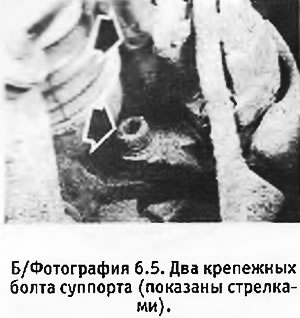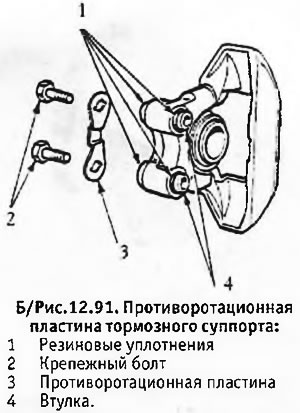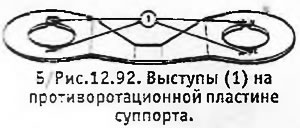2. Loosen the nuts on the front wheels and jack up and support the front of the machine so that the front wheels are off the ground. Apply the handbrake and remove the front wheels.
3. Clean the dirt off the front brakes and disconnect the brake hose from the wheel cylinder on one of the front brakes. Plug the end of the hose to prevent dirt from entering the system.
4. Remove the brake pads (see previous section).
5, Remove the 2 bolts securing the brake caliper to the stub axle (see photo) and remove the caliper.

Brakes
6. Transfer the caliper to the work table and remove the cylinder from the caliper bracket.
7. Remove the rubber boot and pull out the piston. It can be gently blown out by applying compressed air to the brake hose fitting. In order not to drop the piston, you should wrap the cylinder with a rag in advance. If the piston gets stuck in the cylinder, you can moisten the cylinder and piston with impregnating liquid and wait a while to allow it to soak. This will most likely damage the piston seal, but it must be replaced anyway.
8. After removing the piston, remove its seal from the groove in the cylinder wall. Thoroughly clean all metal parts in methanol without the use of abrasive materials or metal scrapers, which may damage the treated surfaces or the anti-corrosion coating.
9. Carefully inspect the sliding surfaces of the piston for scratches, grooves and other defects. If any are found, the piston must be replaced (never try to override it). Inspect all parts of the caliper for obvious defects and replace if necessary.
10. Moisten the new piston seal with brake fluid. Lubricate the inner surface of the cylinder and piston with brake fluid. Carefully install the seal into the groove on the inner wall of the cylinder. Insert the piston, being careful not to damage the seal. Dry the assembled cylinder with a clean, lint-free cloth and install a new rubber boot.
Brakes
11. See TEVES Brake Caliper Removal and Overhaul procedure. In the case of the DBA caliper, the same is true.
Brakes of both types
12. Assembling and installing the brake caliper is done in reverse order. Pay attention to the following points:
- A. Before installing the caliper on the trunnion, carefully clean the bolt holes and the bolts themselves and apply thread locking fluid to their threads. Install new washers on the bolts and tighten them to the desired torque.
- b. Install brake pads (see section 5).
- V. Before installing the cylinder, remove the bleed screw and pour fresh brake fluid into the cylinder, tilting the cylinder in all directions to get rid of air locks. Install the bleed screw.
- d. Install a new copper washer on the brake hose fitting and check that the hose is not kinked after connection. After the machine is lowered onto the wheels, turn the steering wheel in both directions to the stop and check that the hose does not touch the machine parts.
- d. Remove the plastic film or stopper with a sealed vent hole, install on the tank "native" plug and bleed the brake system (see section 3).
Brake caliper modifications on latest models
1. Starting with ID number 9 352 397, the brake caliper anti-rotation plate no longer has lugs. This was done because the tabs on the plate tended to rub against the bushings and restrict the sliding travel of the caliper, resulting in uneven pad wear.

2. If desired, you can remove these tabs from the anti-rotation plate of the caliper on early models yourself.
3. Starting with ID 9 457 811, the seal between the caliper and bushings has been improved. Previously, due to too much clearance between them, the brakes could make noise when reversing.
4. If desired, you can modify the calipers on early models yourself with a special caliper bushing replacement kit. The kit contains 2 bushings, 4 seals and a special bushing lubricant and thread locking fluid that is applied to the caliper bolts.
5. When replacing caliper bushings, take the opportunity to grind off the tabs on the anti-rotation plates.

